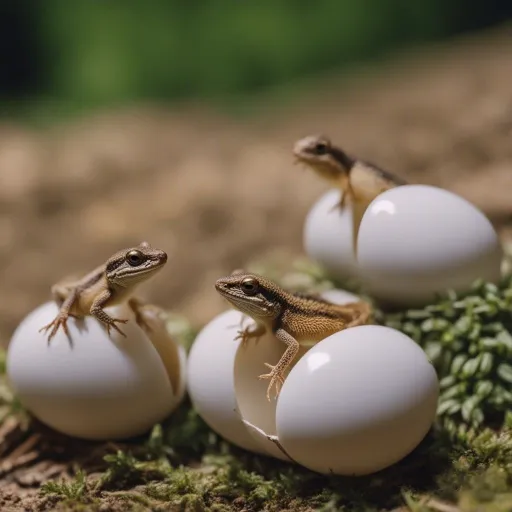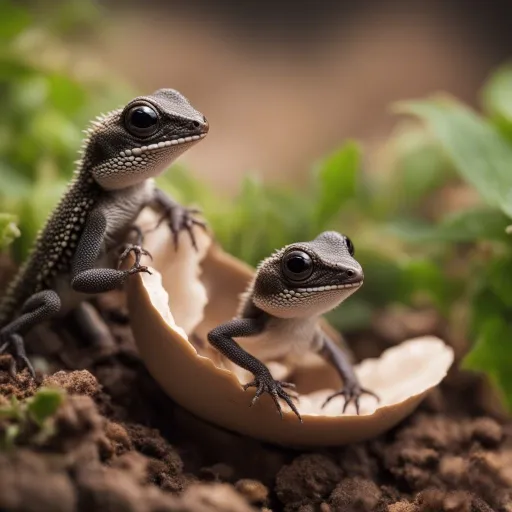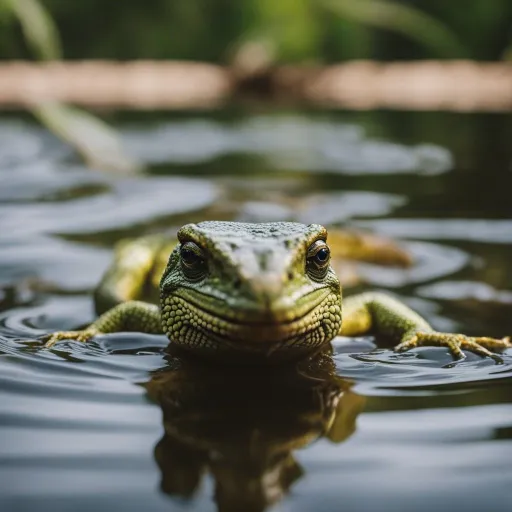Imagine a world where instead of cute little meows or adorable puppy barks, baby lizards scuttled around, free and independent, from the moment they were born. Intriguing, right?
Well, the reality is even more fascinating. In this article, we will explore the remarkable process of how lizards give birth, uncovering the unique strategies and quirks that make this reptilian reproduction truly awe-inspiring.
So, fasten your seatbelts and prepare to be amazed by these little wonders of nature.

Overview of Lizard Reproduction
Lizards, a diverse group of reptiles, have various methods of reproduction. They can reproduce sexually or asexually, each with its own distinct processes.
Sexual reproduction involves mating behavior, internal fertilization, and egg development. On the other hand, asexual reproduction entails the creation of offspring without the involvement of a mate.
Understanding the intricacies of lizard reproduction provides valuable insights into these fascinating creatures.
Sexual Reproduction in Lizards
Sexual reproduction in lizards involves several stages, starting with mating behavior. During this phase, males often engage in elaborate courtship displays to attract potential mates.
They may perform impressive physical feats, such as head bobbing, push-ups, or colorful displays, to capture the attention of females.
Once a female is receptive, copulation occurs, leading to internal fertilization. Unlike many other reptiles, lizards have internal fertilization, wherein the males transfer sperm to the female’s reproductive tract.
This allows for greater control over reproduction and protection of the fertilized eggs.
Following fertilization, the female lizard develops eggs internally. The eggs undergo various stages of development within the female’s body, and the embryos receive nourishment from the yolk sac.
Eventually, the fully formed eggs are ready for the next step in the reproductive process.
Types of Lizard Birth
Lizards exhibit different methods of giving birth, each with its unique characteristics. These methods are oviparous (egg-laying) birth, ovoviviparous (egg-bearing) birth, and viviparous (live) birth.
Oviparous Birth
Oviparous birth is the most common method of reproduction among lizards. It involves laying eggs outside the female’s body. Oviparous lizards produce a hard-shelled egg that is deposited in a suitable nesting site. The female lizard carefully selects an appropriate location to lay her eggs, ensuring they receive sufficient warmth and protection.
Once the eggs are laid, the female’s role shifts to providing ideal conditions for incubation. This includes maintaining the temperature and humidity levels necessary for proper development. The nesting process and the subsequent incubation period helps safeguard the eggs from predators and provide optimal conditions for hatching.
When the time is right, the eggs hatch, and the baby lizards emerge. This process marks the completion of the oviparous birth, where the new offspring gain independence and begin their journey in the world.
Ovoviviparous Birth
Ovoviviparous birth is a unique reproductive method found in certain lizard species. In this process, the female lizard retains the eggs inside her body until they are ready to hatch. While the eggs develop internally, there is no direct connection between the mother and the embryos.
The mother lizard provides nourishment to the developing embryos through the yolk sac, ensuring their growth and survival. The yolk sac contains all the necessary nutrients for the embryos, allowing them to develop and mature without needing external resources.
Once the embryos reach maturity and are ready to hatch, the female lizard gives birth to live young. This birth process resembles viviparity, where the offspring are fully formed and develop within the mother’s body.
Viviparous Birth
Viviparous birth is a remarkable form of reproduction observed in some lizard species. Unlike oviparous and ovoviviparous methods, viviparity involves the direct nourishment of the embryos while they are inside the mother’s body. The embryos receive nutrients and oxygen through a specialized organ called the placenta or yolk-sac placenta.
Embryo development in viviparous lizards is similar to that in other viviparous animals, including mammals. The mother’s body provides a favorable environment for the growth and development of the embryos, ensuring their survival until birth.
When the embryos are fully developed, the mother lizard gives birth to live young. These offspring are capable of independent survival from the moment of birth, equipped with the necessary adaptations to thrive in their environment.
Factors Affecting Lizard Birth
Lizard birth is influenced by various factors, including temperature, habitat, seasonality, and predators. These factors play critical roles in determining the reproductive success and survival of lizard populations.
Temperature plays a crucial role in determining the sex of the offspring in many lizard species. Specific temperature ranges during incubation can lead to the development of either male or female offspring. This phenomenon, known as temperature-dependent sex determination, highlights the importance of environmental temperature in shaping lizard populations.
The habitat of lizards also impacts their reproductive patterns. Different species have adapted to thrive in various environments, ranging from arid deserts to lush rainforests. The availability of suitable nesting sites, food sources, and shelter within their habitats contributes to successful reproduction.
Seasonality plays a vital role in lizard birth. The timing of reproduction is often influenced by changes in environmental conditions, such as temperature and rainfall. Many lizard species exhibit seasonal breeding patterns, ensuring that offspring are born during times of optimal resources and favorable conditions for survival.
Predators are another influential factor in lizard birth. The presence of predators can drive behaviors such as nest selection, timing of reproduction, and parental care. Lizards have evolved various strategies to minimize the risk of predation, ensuring the survival of their offspring.
Parental Care in Lizards
Parental care in lizards varies among species and can be exhibited by both males and females.
Maternal care is common in oviparous species, where females invest significant efforts in nest selection, egg laying, and incubation.
Females often select nesting sites that provide suitable conditions for egg development and protect them from environmental threats.
They may excavate burrows or use pre-existing shelters to create safe spaces for their offspring.
Throughout the incubation period, females carefully monitor nest conditions and may adjust their behavior to ensure optimal incubation temperatures.
Paternal care is seen in some lizard species, where males contribute to the successful reproduction of their offspring.
Males may guard the nesting sites or engage in territorial defense to protect the eggs from predators or rival males.
This paternal involvement enhances the survival chances of the young and contributes to the overall reproductive success of the population.
Nest defense is another form of parental care exhibited by both male and female lizards.
When predators approach the nesting site, parents may display aggressive behaviors, attempt to intimidate or attack the intruders, or even sacrifice themselves to protect their young.
This parental sacrifice illustrates the remarkable dedication and instinctual drive to ensure the survival of their offspring.

Fascinating Examples of Lizard Birth
Several lizard species exhibit unique and fascinating reproductive behaviors and birth methods.
The Green Anole Lizard showcases oviparous birth, where females lay eggs in concealed locations such as leaf litter or tree bark. Males, in contrast, guard their territories to attract females for mating.
Frilled Lizards, native to Australia and New Guinea, possess remarkable courtship and mating rituals.
Males display their iconic frill to attract females, engaging in intense territorial battles. After mating, females lay eggs in nests dug deep within the ground, ensuring protection and optimal incubation conditions.
Gila Monsters, found in the southwestern United States and Mexico, demonstrate ovoviviparous birth.
Although the eggs remain inside the female’s body until hatching, there is no direct placental connection between the embryos and the mother.
Female Gila Monsters give birth to live young, emphasizing the intriguing diversity of lizard birth methods.
Conservation and Lizard Birth
Understanding lizard reproduction and the challenges they face is essential for their conservation.
Lizard populations worldwide are threatened by various factors, including habitat loss, climate change, pollution, and invasive species.
Habitat destruction, such as deforestation or urbanization, can eliminate nesting sites and disrupt vital breeding areas for lizards.
Changes in temperature and precipitation patterns due to climate change can directly affect reproductive success and survival rates.
Conservation measures for lizard populations focus on protecting and restoring habitats, implementing captive breeding programs, and promoting awareness and education about the importance of these reptiles.
By safeguarding their natural habitats and implementing sustainable practices, we can ensure the survival of these remarkable creatures for future generations to enjoy.
Final Thoughts
In conclusion, lizard reproduction encompasses a range of fascinating processes, encompassing both sexual and asexual methods.
The different types of lizard birth, including oviparous, ovoviviparous, and viviparous, offer unique insights into their remarkable adaptations and survival strategies.
Understanding and appreciating lizard reproduction not only enriches our knowledge of these incredible animals but also contributes to their conservation and protection in the face of growing environmental challenges.



